
Native Voices for Native Audiobook: Recording Chapters in CALLING FOR A BLANKET DANCE
I can't tell you how grateful I am to be able to read for my debut novel. Many writers don't get the opportunity to record for their own audiobooks. Because my novel is polyvocal and comes from the heart of tribally specific communities, Kiowa and Cherokee, I was more than happy when Algonquin Books asked me to read for the male characters in my debut. Moreover, they hired a Native actress to read for the women characters: Rainy Fields.
You might know Rainy Fields from her work with Terese Marie Mailhot's debut, HEART BERRIES. Rainy is an enrolled tribal member, Muscogee Creek/Cherokee, and born in Claremore, Oklahoma. I was elated when she signed on to read for the audiobook. She is an experienced Native actress and well-versed in recording audiobooks.
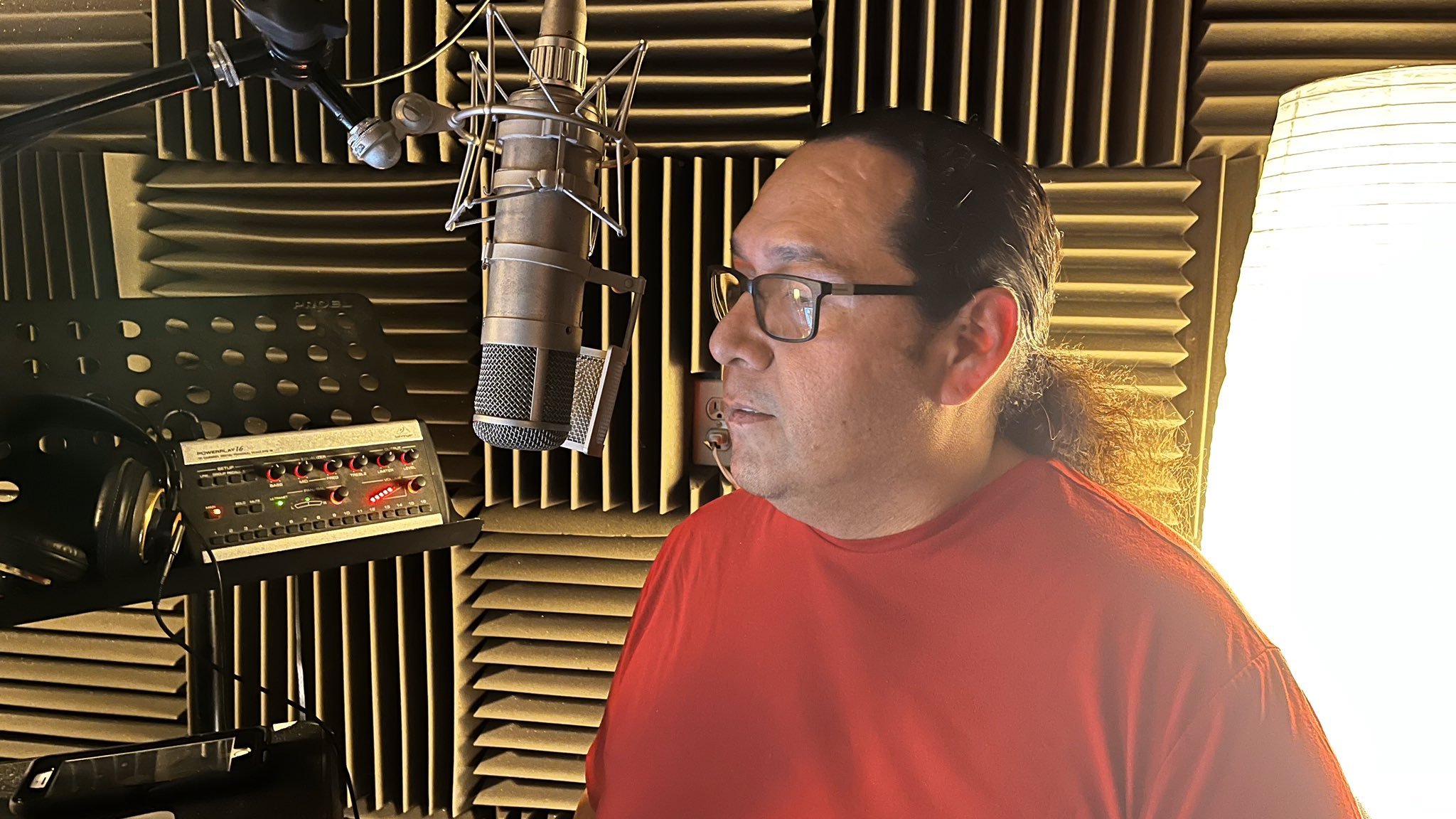
I on the other hand was not so well versed. This was my first time recording anything--much less half a novel. It was fun though. I learned a lot about the world of voice recording. Honestly, I hope I get the chance to do this again. I feel like I caught on quickly. I needed direction at the beginning and the more I recorded the more I caught onto moments when I'd miss a word or add one in.
I was especially interested in capturing the Kiowa and Cherokee inflections in the voices. I've said this before on previous blog posts. While both Kiowa and Cherokee people have Oklahoman accents, there are subtle differences between the two. Kiowa people can almost transform English into a Kiowa-sounding language, whereas Cherokees have a stronger twang to our inflections--a little more singsongy. It was fun being able to move between those subtle dynamics in the two tribal communities I hold so dear.

I have to give a big wado to Blue House Media for coordinating with Hachette Audio/Algonquin Books for these recording sessions. Joel was great, kind, and generous. He quickly took care of any issues and was pleasant company. He made the experience fun and exciting. And of course where would I be without Cameron Potts of John Marshall Media, who directed the entire recording and was an amazing coach, and Laura Essex from Hachette Audio, who oversaw the entire production and gave amazing feedback. I'm feeling very lucky to be a part of such a wonderful and supportive team.

As a Native writer, I was excited to be able to have Native people doing the voices for my audiobook. I'm very grateful Algonquin Books was considerate of this very important cultural dynamic. I'm excited how there are different aspects to the production of the debut novel of which have connected to the three intersecting cultures in my life, Kiowa, Cherokee, and Mexican. While there's always going to be detractors and naysayers (those cliched crabs-in-a-barrel), I'm proud to have been able to connect with artists from both Native and Mexican communities.
Mona Susan Power's Praise for Oscar Hokeah's Debut Novel: CALLING FOR A BLANKET DANCE
You have to understand how big of a fanboy I am. When someone asks me for a book recommendation, Power's story collection, ROOFWALKER, is usually the first I name. It captures perfectly the flux between community/reservation life to an urban Native experience. I have a special love for the book because I taught it in my Native Lit class at the Institute of American Indian Arts. This was back in 2013 when the then Head of Creative Writing, Evelina Zuni Lucero, asked me to adjunct for a semester. When I compiled my list of Native fiction to teach, Mona Susan Power's book was at the top.

When my editor, Kathy Pories, of Algonquin Books asked me to reach out to Native authors to request blurbs, I immediately thought, it'd be a dream to have Susan Power's blessing. Then I figured it was far fetched. There was no way Susan Power would be able to read my book. Here I am a nothing little Native writer from nowhere Oklahoma. She's not going to respond to me. But Kathy assured me that writers are more inclined to respond to other writers in these situations. I'm so new to all this, being a debut author, and I'm still learning as I go. I trusted Kathy and thought, okay I'm going to give it a shot in the dark.

Mona Susan Power is most well-known for her own debut novel, THE GRASS DANCER, which was released in 1994. It's described as "the harsh price of unfulfilled longings and the healing power of mystery and hope. Rich with drama and infused with the magic of the everyday, it takes readers on a journey through both past and present—in a tale as resonant and haunting as an ancestor’s memory, and as promising as a child’s dream." Her debut novel is published by Penguin Random House, and won the Ernest Hemingway Foundation Award for First Fiction. The novel received praise from numerous news sources, including The New York Times, Washington Post, and the Chicago Sun. Additionally, Louise Erdrich and Amy Tan gave beautiful blurbs for the novel.

The short story collection I mentioned above, ROOFWALKER, was released in 2002 from Milkweed Editions, and described as "a world in which spirits and the living commingle and Sioux culture and modern life collide with disarming power, humor, and joy. The characters grapple with potent forces of family, history, and belief—forces that at times dare them to do more to feed their identity, and at times simply paralyze them. Rich with women who do things, this book gives voice to characters who make space for contradictions in their lives with varying success and, by extension, live the 'Indian way' to varying degrees." This short story collection resonated powerfully with students in my Native Lit class and I highly recommend instructors to add this one to their lists. Moreover, Louise Erdrich described ROOFWALKER as "A book of wild humor and compassion." I can't sing enough praise for this book. I loved the depth of the characters and how each story stacked atop each other like bricks, capturing an emotionally rich experience of a Native community.

Her latest novel, SACRED WILDERNESS, was released in 2014 by Michigan State University Press. It's described as "A Clan Mother story for the twenty-first century, Sacred Wilderness explores the lives of four women of different eras and backgrounds who come together to restore foundation to a mixed-up, mixed-blood woman—a woman who had been living the American dream, and found it a great maw of emptiness. These Clan Mothers may be wisdom-keepers, but they are anything but stern and aloof—they are women of joy and grief, risking their hearts and sometimes their lives for those they love. The novel swirls through time, from present-day Minnesota to the Mohawk territory of the 1620s, to the ancient biblical world, brought to life by an indigenous woman who would come to be known as the Virgin Mary. The Clan Mothers reveal secrets, the insights of prophecy, and stories that are by turns comic, so painful they can break your heart, and perhaps even powerful enough to save the world. In lyrical, lushly imagined prose, Sacred Wilderness is a novel of unprecedented necessity."
I was excited to cross one of her Facebook posts the other day, where she announced she had recently acquired a literary agent for a NEW NOVEL! Yes! I'm very excited for her next novel, A COUNCIL OF DOLLS, to find a home with a publisher. I'll be placing it on pre order ASAP! From what I understand, it appears to be in early stages with an agent, but I'll be keeping a look out for this novel in the future--hopefully near future.
Needless to say, after giving it a shot in the dark, I unexpectedly received a response from Mona. I couldn't believe it. I quickly clicked on the popup for Facebook Messenger and her message showed on my iPhone's screen. I read the words "thank you for teaching my work" and "congratulations on finding a wonderful publisher," and I half expected her to be too busy and not be able to read my debut novel. Then I read the words "I'd be honored to have an early read of your forthcoming work." I thought, what? So I read the words again, "I'd be honored to have an early read of your forthcoming work." I couldn't believe it. She said, "Yes." Mona Susan Power said, "Yes."
I clicked over to my email and typed as fast as my fat thumbs would allow, sending Kathy Pories and my agent, Allie Levick, the good news. They both emailed back quickly with excitement. We were all delighted to have Mona give the novel a chance.
Then came the waiting. Oh, the waiting. It's more the wondering. Maybe the not knowing, but hoping. I'm such a fanboy. I called a close friend and told her, "Susan Power is reading MY book." I was excited and nervous to hear her thoughts. What would she think of the main character, Ever Geimausaddle? How will she respond to the tri cultural intersections? Did I capture Oklahoma's intertribal dynamics well? If there is ever anyone you want to impress, it's someone you've admired for so long.
Then a few weeks passed and she responded. Again, I saw the notification for Facebook Messenger and I immediately clicked it as soon as it hit my screen. Then I couldn't believe what I read. It was filled with such wonderful praise. I just couldn't believe she enjoyed my book. I'm excited to share with you Mona Susan Power's praise for my debut novel:

"CALLING FOR A BLANKET DANCE is a stunning novel I couldn't stop reading! Oscar Hokeah writes from deep inside the heart of his communities, bringing life to generations of voices who became so real to me they felt like relatives. The reader can't help but invest in each character as they navigate bitter challenges, sometimes surprising themselves with their strength, their ability to survive and love. Hokeah's prose gorgeously weaves authentic local vernacular with the lyrical notes of hard-won insight. This novel belongs on every recommended booklist for fans of literary fiction!"
My debut novel will release next year: July 26, 2022. Right now it's available for pre order at most online retailers, but I do like to promote Bookshop because it gives a portion of the money to a local book store in your area.
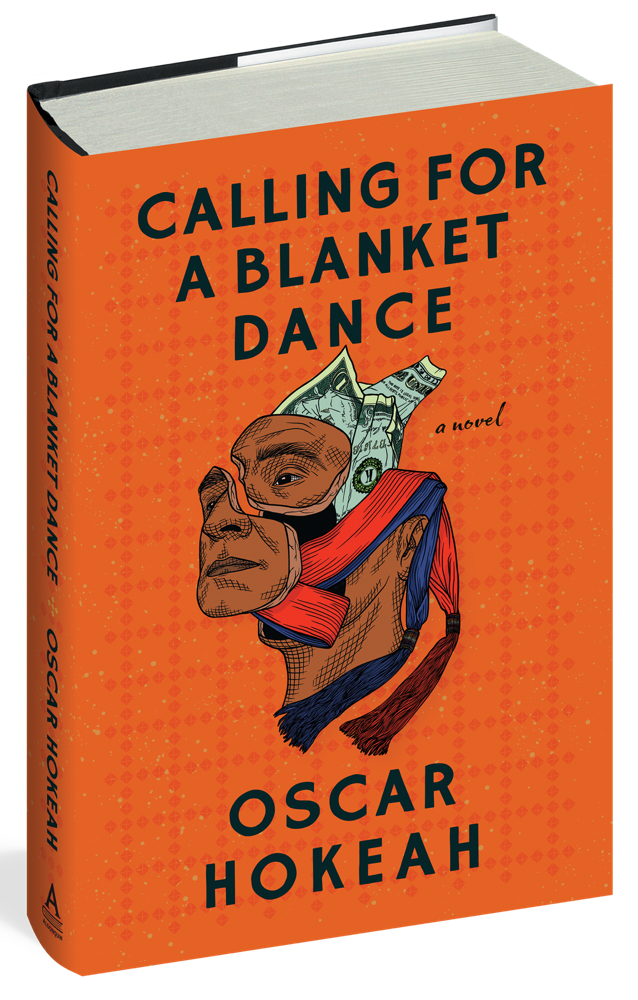
I'm so very grateful Power was willing to give my novel a chance. And super delighted for her wonderful praise. I'm still floored by her generosity in helping a new Native writer come on the scene. It's not easy. Especially as you're learning as you go. I feel very humbled by all this. I really can't express enough how grateful I am.
The heart of the novel has to do with family, naw thep’thay’gaw, and how families show up for each other. The title of the novel comes from an important ritual in powwow culture. When we call for a blanket dance, in essence what we’re doing is asking for the community to step up and help out someone in need. The main character, Ever Geimausaddle, has a host of family members willing to do just that, willing to hear the call, step up to the edges of the blanket, and offer a piece of themselves for his greater healing.
The structure of the novel is told in 12 chapter/narrator fashion, and we hear from different family members–grandparents, aunties, uncles, cousins, and then in the last chapter Ever Geimausaddle speaks for himself. Ever’s identity becomes shaped by Kiowa, Cherokee, and Mexican relatives, and the crux of the novel has his family concerned for his changing identity as a man. His Cherokee grandmother, Lena Stopp, fears the brutal trauma he experiences as an infant will forever leave him “witched,” while his Kiowa grandfather, Vincent Geimausaddle, fights to change Ever’s fate with his dying breath. Moreover, his Mexican American cousin, Araceli Chavez, is the conduit for deep familial healing. So family member after family member step up to the edges of the blanket to offer a piece of themselves. But will this be enough?
As Ever grows into adulthood, readers will get to explore large and unique themes situated in tribally specific values, like tribal matriarchy, communal ideology, and collective identities. Furthermore, readers will follow Ever Geimausaddle through the ups and downs of living an intertribal and multicultural life in Oklahoma, offering a slice of America very few know about.
Novel DNA: How Writing Chapters can Change the World
What to do with a great idea? Let's sit down and map out a novel. Writing in the dark is a popular way of writing short stories. We get an idea. We pull out the laptop. We write until everything is on the page. As we write, we don't know where the story will lead and this suspense and feeling of surprise keeps us writing, it builds adrenaline, and keeps us guessing as we finish a story. But there may need to be a different approach when it comes to a 25 chapter novel.
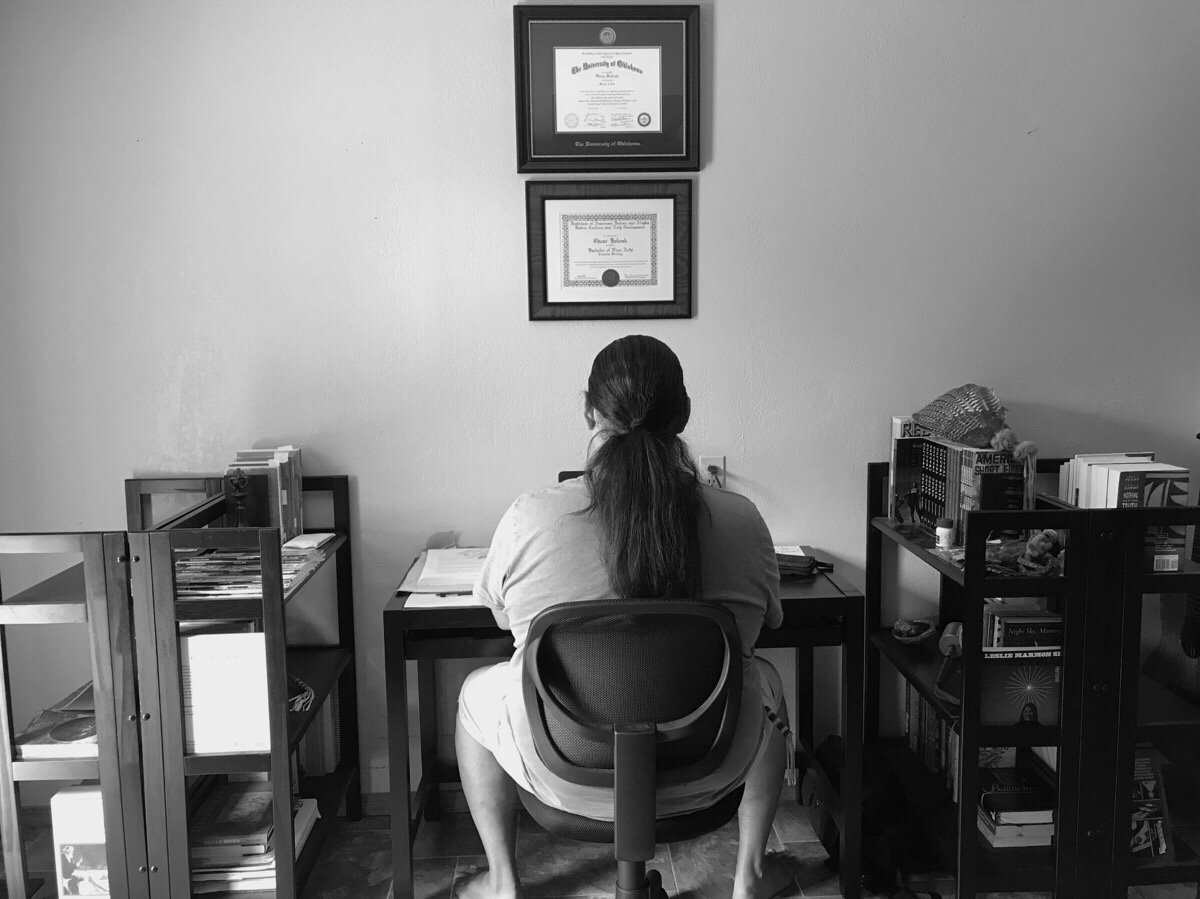
I'm not going to tell anyone how to write. We all have our nuanced approach. But what I'm going to do is share with you how I go about writing my novels. And where novel writing can be different and similar to short story writing. We've all gotten to the point where we've asked ourselves: How do I write a novel? Do I outline? If so, how do I outline multiple chapters to create an interesting story arch? Do I write in the dark for 80,000 words? If so, will my novel have deadly and boring lulls?
Do a little cross compare with my approach and fill in with your personal style. Make the process your own. That's one of the important components to any creative approach.
First thing I do: Create a OneNote file. The tabs work great to create space for each individual chapter. I always have a "development" tab, where I create multiple pages for subjects like characters, plot, subplots, story arch, etc. But I create a tab for each chapter so I can brainstorm elements within each chapter. What I need to consider for one chapter is not going to work for another. If there is a clear build up and tension to the novel, then every chapter will need a lot of space to create the nuances.
Example: If the main character is taking a child into custody in the first chapter, then I'll need space to brainstorm her approach, which will be determined by the other characters confronting her and how she will overcome that confrontation. This is radically different than the second chapter, where the main character might be confronting a whole different situation, like children adjusting to a new foster home.
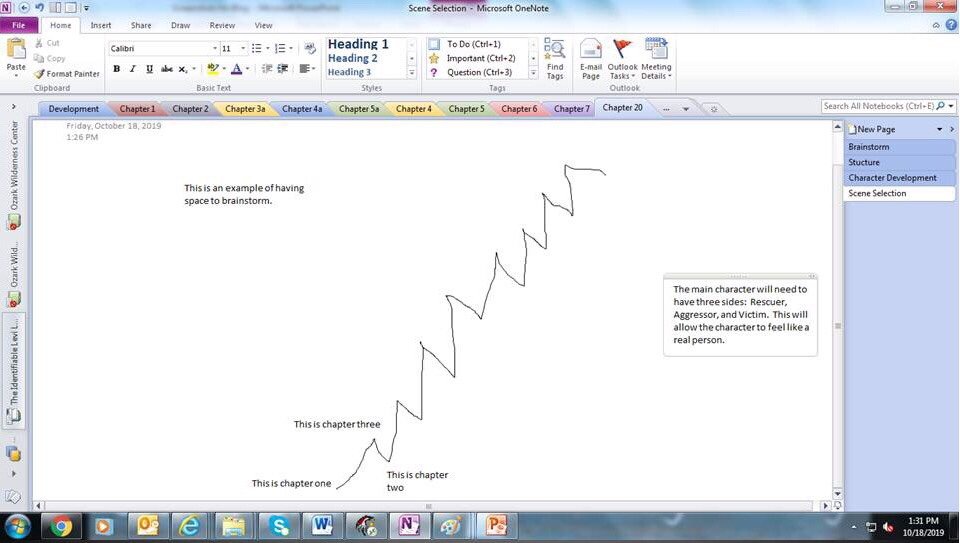
Also, I like to have all the tools in OneNote. I can draw out the build up as you can see in the image above. I can also write text boxes for each idea I need to address for development. I can also move those boxes around.
So once I have the space established to develop my novel, I then go into writing a "synopsis" of sorts. It's a line by line breakdown of the novel. It's not a full synopsis by any sorts but it gives me a quick snapshot of the progression of the main character's obstacles. Also it gives me an opportunity to consider subplots. In a novel, it's important to establish subplots that mirror or give us a break from the main story line.
Example: If the main character is a young man who is trying to overthrow his corrupt boss, then the reader will need to take a break from the ugliness transposed between the two. We can see him with his family and his family gives him stress relief as he battles with this boss, but it will simultaneously show the family putting pressure on him to be successful at work. The subplot shows a different side to this young man, and it also adds to the tension while giving the reader an alternate storyline to follow.
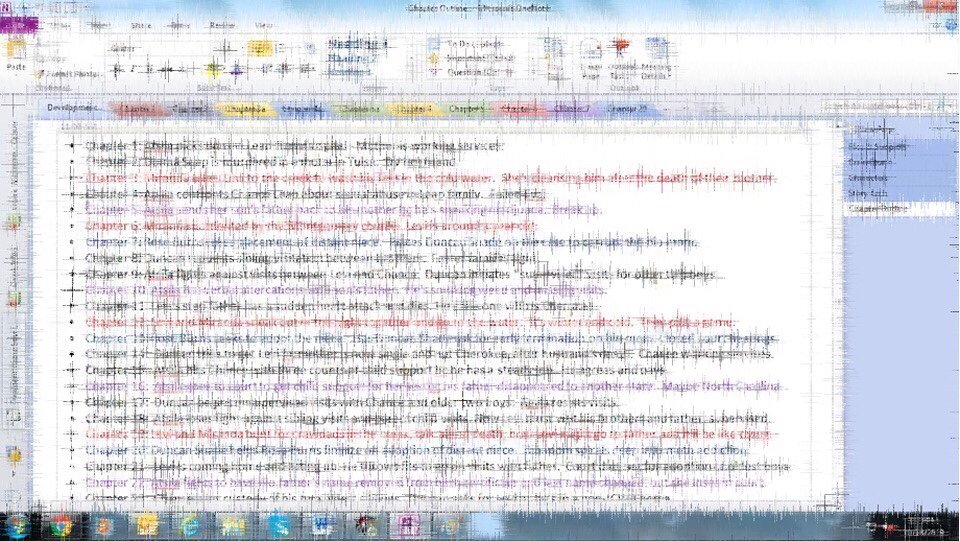
So I had to "shear" the screen because the above image is a screenshot from the current novel I'm working on. I don't want to give away any details in the novel before it reaches fruition. But as you can see in the above image, it shows a "list" of each chapter from chapter one to chapter 25. I'd also like for you to notice the different colors on each line. There are chapter breakdowns in black, red, blue, and purple. The black represents the main plot line, the red is a tightly related subplot (a subplot closely aligned with the main plot), while the blue and purple are subplots that show a seperate but nuanced mirror to the main plot (gives the reader an emotional "break" from the plot while also increasing tension).
You're probably asking why I go to such lengths to map out my novels. For me the pleasure of writing isn't only in the initial creation of a piece. I like the practice of "writing in the dark" when it comes to short stories. But when we're trying to hold someone's attention for a long period of time, there needs to be numerous components to keep the reader entertained. This is the reason I write. For other people to have as much pleasure reading the novel as I had creating it. When it's two fold, we as writers get more in return because then we have happy fans who are eager to talk about and share our writing. In order to reach that goal, there is a lot of layers to create.
I enjoy the macro development as much as the micro. As I create the big picture, outlining chapter by chapter how the main character will survive all the obstacles I throw in her way, the concept building can be euphoric. It's a physical reaction. After I've written the first draft and I'm finally ready for the details (the micro), I'm getting adrenaline from witnessing the spirit of the novel come alive in the words. Suddenly, my idea that corruption can be beaten becomes emotionally tangible when the main character throws a fist full of contracts into an evil boss's face. It all comes together.
There is nothing more exciting than seeing the DNA of a novel build word by word into a complex living system. And it takes hard mental labor to structure a story so perfectly that someone can read your work and suddenly choose to transform their worldview to include people you know and experiences you've lived. To make that connection, it's worth all the time, thought, and energy spent.
Support a Native owned Etsy shop, Allies United, where I offer unique merch for allies of social justice movements, like MMIW, Native Lives Matter and Black Lives Matter. Take a look inside my Etsy shop here: etsy.com/shop/AlliesUnited.
Lies, Love, & Magic: How Voice was Hijacked by Editor Mysticism & Workshop Critique BS!
The sought after and mysterious "voice" of writing. You watch editors salivate like Derridean defeatists about how magical voice can be when it "makes your foot tap to the rhythm." Aww, how romantic. We are lovely romantic beings who need magic in our lives. Well, I'm about to take the magic out of the what, where, and how to find a literary voice. For writers, we don't give a shit about magic. Our job is to deconstruct the process and lay it all out for other writers. We are here to help each other learn the tricks to make the magic happen for readers, which is why editors love to talk about the mysterious quality of writing. Because ultimately they are fans of literature. They are readers. We reader/writers--the ones who create the magic--must abandon all notions of romanticism. We're here to work. Why? Because we love the secrets of writing as much as we love the process. Because we love to make the magic and watch the readers read in awe.So if you've hit the google machine with a "how to find your voice" or "what is voice in literature" or "what is a writer's voice" then you've come to the right spot. I'm about to break this bad boy down.First and foremost I need to tell you what voice is not. So when we go to write we need the reader to see what we see as writers. The reader needs to be able to visualize the scenes as they play out in the course of our short story or novel. That is the action. That is description. The nuts and bolts.
For writers, we don't give a shit about magic. Our job is to deconstruct the process and lay it all out for other writers. We are here to help each other learn the tricks to make the magic happen for readers, which is why editors love to talk about the mysterious quality of writing. Because ultimately they are fans of literature. They are readers. We reader/writers--the ones who create the magic--must abandon all notions of romanticism. We're here to work. Why? Because we love the secrets of writing as much as we love the process. Because we love to make the magic and watch the readers read in awe.So if you've hit the google machine with a "how to find your voice" or "what is voice in literature" or "what is a writer's voice" then you've come to the right spot. I'm about to break this bad boy down.First and foremost I need to tell you what voice is not. So when we go to write we need the reader to see what we see as writers. The reader needs to be able to visualize the scenes as they play out in the course of our short story or novel. That is the action. That is description. The nuts and bolts.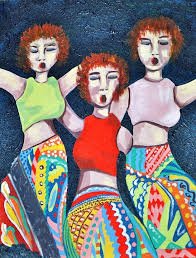 For example, if I write, "Dean took a step forward and gazed at the interesting ropes above." That is me describing action. This is the story. I'm going to say that again and put it in bold letters for emphasize. Okay, here goes: Action is the story. This is not the voice. The story is the most important part of writing. Not voice. I'll dispel voice in this post and then you can get to the real work: writing the story. It is the first and last thing you need to be thinking about when writing your short story or novel. You need to be focused on scene selection. Select your scenes in the sequence in which lays out the action to conclude on the climax. Scenes are the walls and floors of the house. Action and description are the nails and mortar holding the walls and floors together.Now it's time to decorate the house. Now "voice." Ready to dilute your desperate need for magic. Ready to grow up as a writer. Here goes. Voice is simply the insight, wisdom, and judgements of the narrator.So now I can hear people yelling at the computer screen. You need to take a breath. Life is not that hard. Take a minute and let me elaborate. I'll prove myself right. Oh, no wait, I'll allow you your "voice" and let you be the judge of that.
For example, if I write, "Dean took a step forward and gazed at the interesting ropes above." That is me describing action. This is the story. I'm going to say that again and put it in bold letters for emphasize. Okay, here goes: Action is the story. This is not the voice. The story is the most important part of writing. Not voice. I'll dispel voice in this post and then you can get to the real work: writing the story. It is the first and last thing you need to be thinking about when writing your short story or novel. You need to be focused on scene selection. Select your scenes in the sequence in which lays out the action to conclude on the climax. Scenes are the walls and floors of the house. Action and description are the nails and mortar holding the walls and floors together.Now it's time to decorate the house. Now "voice." Ready to dilute your desperate need for magic. Ready to grow up as a writer. Here goes. Voice is simply the insight, wisdom, and judgements of the narrator.So now I can hear people yelling at the computer screen. You need to take a breath. Life is not that hard. Take a minute and let me elaborate. I'll prove myself right. Oh, no wait, I'll allow you your "voice" and let you be the judge of that.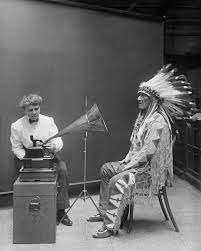 So let's take the previously used example and rearrange it. Go back up and read if necessary. It was straight forward description. Now if I insert voice it might sound like, "Dean impulsively stepped forward (might know)--did his best to understand the intersecting ropes above." So with the quick insertion of an adjective "impulsively" and a quick but subtle judgement "did his best" I've cast judgement on Dean's actions. And the addition of (might know) is a Kiowa cultural judgment, so the "voice" is Kiowa and it is being judgemental of Dean's action.You can follow up the sentence with a bit of judgemental wisdom and add, "Still a monsape tali for his age (mid twenties) and you know how they say tali brains don't develop as fast a mautaun." So I've inserted a lot of Kiowa language into that one sentence but you can quickly assess by context the "voice" is making a judgement on the main character. By deduction and pop culture, you participate in the reading and deduce tali means boy and mautaun means girl. Why? Because it's commonly understood male brains develop slower than female brains.All I did was use judgement, insight, and wisdom. That's it. Nothing else. I did a little sentence play, and did my hyperlocal thing (indicative of my writing style). But I argue this: those pauses don't come until first you cast judgement, insight, and wisdom. I believe this to my core. So much so, I challenge you to take a straight forward sentence in your own story, add judgement (good or bad, love or hate doesn't matter), and all of a sudden you'll start putting in pauses and/or running sentences long. It is the judgement, insight, and wisdom that shapes the sentence. Hear me say that again: It is the judgement, insight, and wisdom that shapes the sentence.The Kiowa and hyperlocal tone all comes from judgement, insight, and wisdom. All our families and communities have it regardless of culture. In fact, as my mind starts to process the three aspects I mentioned, the tone of the community comes out. It is taking our mind space and inserting the value judgements which are already imbedded in us and using it as a tool to rearrange sentences. That's how you get those amazing sentences the great writers write, and that's how they developed their "voice."My favorite writers are N. Scott Momaday, Louise Erdrich, Gabriel Garcia Marquez, Alice Munro, and Junot Diaz. Take your pick. Go read their work, and then come back to me and tell me I'm wrong. In fact, I dare anyone to try to argue differently.
So let's take the previously used example and rearrange it. Go back up and read if necessary. It was straight forward description. Now if I insert voice it might sound like, "Dean impulsively stepped forward (might know)--did his best to understand the intersecting ropes above." So with the quick insertion of an adjective "impulsively" and a quick but subtle judgement "did his best" I've cast judgement on Dean's actions. And the addition of (might know) is a Kiowa cultural judgment, so the "voice" is Kiowa and it is being judgemental of Dean's action.You can follow up the sentence with a bit of judgemental wisdom and add, "Still a monsape tali for his age (mid twenties) and you know how they say tali brains don't develop as fast a mautaun." So I've inserted a lot of Kiowa language into that one sentence but you can quickly assess by context the "voice" is making a judgement on the main character. By deduction and pop culture, you participate in the reading and deduce tali means boy and mautaun means girl. Why? Because it's commonly understood male brains develop slower than female brains.All I did was use judgement, insight, and wisdom. That's it. Nothing else. I did a little sentence play, and did my hyperlocal thing (indicative of my writing style). But I argue this: those pauses don't come until first you cast judgement, insight, and wisdom. I believe this to my core. So much so, I challenge you to take a straight forward sentence in your own story, add judgement (good or bad, love or hate doesn't matter), and all of a sudden you'll start putting in pauses and/or running sentences long. It is the judgement, insight, and wisdom that shapes the sentence. Hear me say that again: It is the judgement, insight, and wisdom that shapes the sentence.The Kiowa and hyperlocal tone all comes from judgement, insight, and wisdom. All our families and communities have it regardless of culture. In fact, as my mind starts to process the three aspects I mentioned, the tone of the community comes out. It is taking our mind space and inserting the value judgements which are already imbedded in us and using it as a tool to rearrange sentences. That's how you get those amazing sentences the great writers write, and that's how they developed their "voice."My favorite writers are N. Scott Momaday, Louise Erdrich, Gabriel Garcia Marquez, Alice Munro, and Junot Diaz. Take your pick. Go read their work, and then come back to me and tell me I'm wrong. In fact, I dare anyone to try to argue differently.
Support a Native owned Etsy shop, Allies United, where I offer unique merch for allies of social justice movements, like MMIW, Native Lives Matter and Black Lives Matter. Take a look inside my Etsy shop here: etsy.com/shop/AlliesUnited.
(Images used in this post are not the property of the author. They were borrowed from Wikipedia, PxHere, and Pixabay)